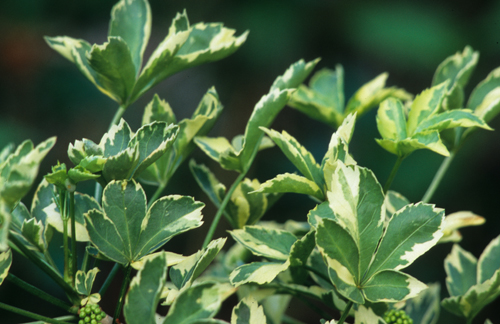Eleutherococcus sieboldianus ‘Variegatus’
variegated five-leaf aralia


© Richie Steffen / Great Plant Picks

© Richie Steffen / Great Plant Picks

© Richie Steffen / Great Plant Picks
Outstanding Qualities
The pure, clear, creamy white variegation of variegated five-leaf aralia makes it sparkle in the garden. Its leaves are divided into five leaflets, attached like fingers in a hand and creating a fine-textured, airy effect. This deciduous shrub is extremely tough and hardy. It tolerates a wide range of growing conditions, including difficult city conditions, such as poor soils and heavy pollution. Adaptable in growing habit as well cultural requirements, it can be sheared to make a colorful hedge. Short spines at each leaf bud along the stems add to the barrier protection of the hedge, but they are not large enough to be problematic during routine maintenance. Left to grow freely it forms a shrub to about 6 or 7 feet tall and about equal in spread. Plant this shrub (often listed and sold under its old name Acanthopanax sieboldianus 'Variegatus') in shady spots where its bright foliage shines. It looks good with black mondo grass and other plants with dark foliage.
Quick Facts
Plant Type: shrub
Foliage Type: deciduous
Plant Height (10-year): 7 ft. 0 in. (2.13 meters)
Plant Width/Spread (10-year): 7 ft. 0 in. (2.13 meters)
Plant Height-Mature: 10 ft. 0 in. (3.05 meters)
Plant Width-Mature: 10 ft. 0 in. (3.05 meters)
Hardiness: USDA Zones 5 to 8
Flower Color: white
Sun/Light Exposure: light to deep shade
Water Requirements: occasional watering during the driest weather
Culture Notes
This tough and adaptable shrub will grow in light to deep shade in well-drained soils, although it will tolerate sandy or clay soils if they are not waterlogged. Once established it only needs occasional watering during the driest weather. If all-green leaves appear prune out the branch to keep the variegation uniform. This shrub responds well to pruning and can be kept as a rather dense bush. It is best to prune in winter or in early to mid-summer.
Text and photos ©2020 Great Plant Picks/Elisabeth Carey Miller Garden except where otherwise noted
Funded by the Pendleton and Elisabeth Carey Miller Charitable Foundation, The Seattle Times, and Individual Donors
Administered by the Elisabeth Carey Miller Botanical Garden
